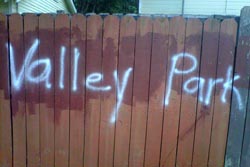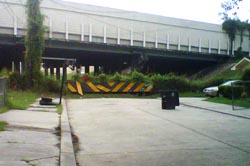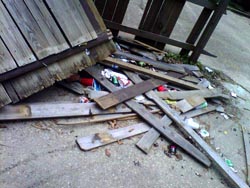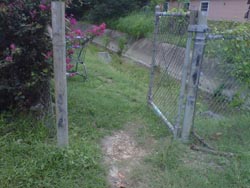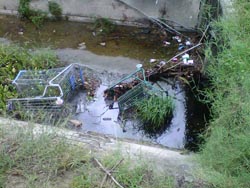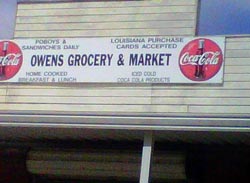Between an Interstate and History: Community Displacement and Neighborhood Storytelling in Valley Park, Louisiana
By Douglas Mungin
Personal narratives serve an important role in the creation and disbursement of knowledge. We will always believe stories more than facts.
—Mercilee Jenkins
In 1958, the State of Louisiana planned to extend Interstate 10 through East Baton Rouge Parish. The interstate would extend from the Mississippi River Bridge to the existing Airline Highway, a distance of about eight miles dividing the city in two parts. The Louisiana Department of Highways cited route locations “chosen are those having the highest benefit-cost ratios, and will not only serve the needs of through traffic, but will also serve local traffic in the communities and local cross-river traffic to provide the maximum traffic benefit” (Interstate Highway System at Baton Rouge, La. Phase 1 Report 1958). The construction of the interstate significantly affected Baton Rouge, Louisiana, and created several issues for city residents, for example confusing detours (State Times, November 1, 1960)1 and construction delays (Morning Advocate, February 14, 1967), but also initiated business development of the downtown Baton Rouge area (State Times, September 18, 1964).
The African American communities of Baton Rouge were most affected by the interstate, and the impact on predominantly African American communities by the construction of the Interstate highway system dates back to the 1950s and 1960s (Bauman, Biles, and Szylvian 2000: 6). Large sections of homes and businesses were uprooted to make way for this construction, forcing many residents to leave their communities and causing many established communities to pick up the pieces and rebuild their communities around the interstate highways. An example of this is the community of Old South Baton Rouge, which Interstate 10 cut a swath through the community. More than four hundred houses were torn down to make way for the elevated highway (Hendy 2009). The impact of the community division is highlighted in the incidents of late 1964 when African American school children were cut off from their normal routes to school:
A major problem centers around several Negro schools between Louise Street and City Park Lake where the six-lane highway system is on the ground. It cuts off Negro neighborhoods, to varying extents, from Buchanan, McKinley Junior High and McKinley Senior High Schools. As a result, numbers of Negro children on their way to and from the schools cross the expressway everyday as a shortcut to school, creating a traffic hazard that has gotten on motorists' nerves and prompted the police department to issue repeated statements about the dangers of crossing through a six-lane thoroughfare (State Times, December 10, 1964).
Many African American communities saw previous stable communities split in half by the interstate development. The community of Valley Park, located near the southern point of Baton Rouge, represents the many African American communities affected by the construction.
The Valley Park area was a working class African American community with a high percentage of home ownership.2 The community bordered the city limits of Baton Rouge at Acadian Avenue, contained the city dump until the early 1970s, and was adjacent to the fledging College Drive and Corporation streets. The immense change the interstate brought to the area was not lost on locals, nor did locals ignore the possibility that the community's identity was the very reason why it was chosen to be altered. Sixty-one-year-old Vernon “Duke” Pritchard, a Valley Park Resident, expressed this sentiment to me in a conversation:
I really don't know. I don't know . . . uh. It's just like that for South Baton Rouge. The whole mapping that they did, it went predominantly through all black neighborhoods. I guess they thought they could move them out and pay a little less than going through the white neighborhoods. Yeah, I feel it's strictly a black and white thing. Anyway, they put that Interstate there and it caused havoc on people having to go all the way out to just go straight down the street. . . . When the Interstate came through, that caused a problem. A lot of people didn't want to move and a lot of people were wondering why the city picked this neighborhood and split it in half.3 (Pritchard, personal communication, October, 29, 2011)
Since the construction of the Interstate 10 through the Valley Park community, additional external factors have contributed to the disappearance of the community's border. In the 1980s additional lanes to the interstate were created (Morning Advocate February 28, 1999). In the 1980s, College Drive became a commercial center and developers bought property from former Valley Park residents. In addition, highway walls were constructed as noise barriers in the early 2000s (Morning Advocate, December 17, 2001). These incidents, along with the graying of the neighborhood, generational flight, and decreased home ownership have created a situation in which a community that was once one of the more vast and populous African American communities in Baton Rouge is today an eight-block community still recovering from gang and drug explosions of the earlier part of the last decade and on the verge of being bought out by developers in the next ten years.
Due to socio-historical and economic factors, Valley Park is isolated from many communities and larger social agencies, relying instead on a network of church meetings and long-standing interpersonal relationships. This study uses narratives and conversations from former and present members of this community as well as performative writing to find out if neighborhood storytelling offers an opportunity for individuals to construct belonging and generate community. This paper seeks to apply the neighborhood storytelling theory to help understand how a community uses the infrastructure and environment around them to tell their neighborhood story. Further, this paper seeks to apply communication infrastructure theory (CIT) outside of the Los Angeles area, where most of that type of research is done. Structural variables used in many network storytelling analyses focus on home ownership and neighborhood tenure as a way to gather a sense of belonging. Since the community in Valley Park is composed of a large rental base with a graying home ownership base, one goal of the paper is to consider how these changing variables relate to an individual's belonging in a community and if and how that sense of belonging is expressed in their storytelling.
The relationship between a neighborhood and how it views itself is articulated and created through the process of storytelling: “Storytelling [is a] process that motivates people, individually and collectively, to engage in those communication behaviors that establish subjective and objective belonging—an attachment to a residential area that is evidence in everyday exchange behaviors” (Ball-Rokeach, Kim, and Matei 2003: 391). While individual storytelling and narrative models in communities have been explored (Fisher 1989), the discursive nature in which community members create shared stories offers us tremendous ground to understand how neighborhood identities are created. The neighborhood storytelling model of (Ball-Rokeach, Kim, and Matei 2003) engages us to view this model as a way to “emphasize the active construction of neighborhoods through discourse. Storytelling is the act of constructing identity through narrative discourse, and storytelling neighborhood is the act of constructing an identity as a member of a residential neighborhood” (394). Many scholars have addressed the narratives that emerge from communities in the midst of urban development but this study hopes to see how these narratives are constructed to create community identity from long-term residents through storytelling.
CIT offers “a theoretical framework that differentiates local communities in terms of whether they have communication resources that can be activated to construct community, thereby enabling collective action for common purpose” (Ball-Rokeach et al. 2001: 173-174). This theoretical approach considers the nature of storytelling within the community and its ability to create culture. “Community,” CIT asserts, “is built on shared discourses about who the community members are—their identities, desires, and shared lived experiences—what their most important opportunities, obstacles, and issues are, and what/how they should do to address them” (quoted in Offe 1980: 177; see also Tilly 1978). Ball-Rokeach's theory of communication infrastructure is extremely useful because it sheds light on the difficult problem of modern urban communication theory and creates a more inclusive consideration of the interplay between interpersonal and mediated storytelling systems and their contexts.
Neighborhood storytelling under communication infrastructure theory relies on three components: macro, meso and micro. Macro agents tell stories primarily about the whole city, the nation, and even the world, where the imagined audience is broadly conceived as the population of the city, county, or region. Meso agents are more focused on a particular part of the city and, in some cases, on certain residents of that area. Although micro agents or networks of neighbors tell stories about many things far from their neighborhoods, they nonetheless carry the most concrete burden of storytelling neighborhood (Bauman, Biles, and Szylvian 2012). Valley Park is a generative site for the storytelling system under this model due to the linkages between the different levels of agents and reflects the hard truth of the impact that interstate development has had in displacing citizens and communities from the larger city.
This paper also engages in performative writing as a way to engage the subject that is the Valley Park community. Critical ethnographer Soyini Madison states that is important to frame the voice and body of the ethnographer in the process of doing ethnography: “It is the active, creative work that weaves the life of the mind with being mindful of life, of merging text with the world, of critically traversing the margin and the center, and of opening more and different paths for enlivening relations and spaces” (172). Autoethnography creates the blurring of boundaries that have traditionally separated researcher from researched and the research itself, research from literature, and the personal from the academic (Bochner and Ellis 1992; Ellis 1997, 2004; Ellis and Bochner 1996, 2000; Ronai 1995). Autoethnography operates as an exercise of the dialectical. As Conquergood (1991) states, “Ethnography is an embodied practice; it is an intensely sensuous way of knowing” (180). For communities that have been traditionally subjugated, it is important to engage in a process of generative discourse with these communities. By adopting these approaches, this study is a partial representation of this engagement.
These factors shape the way a neighborhood identifies itself and the way a community chooses to tell its stories. The community shares these stories through personal narratives that are dictated by historical factors. I argue that these neighborhood narratives are attempts to move focus away from progressive histories that conceal the social production and spatial practices of community members. These progressive histories augment the impact of individual communities in favor of larger fact-based narritives. These city-based histories maintain that individual communities are the byproduct of larger more important events constructed by linear events, great architects, visionary urban planners, etc. This traditional viewpoint conceals the immediate social production of a community's spatiality. Through the performance practices of placing narratives and discourse as the locus of analysis these neighborhood stories offer an intervention in the way we view how agency, practices, and lived experience of even those perceived as being the least influential residents of a city can be a significant part of the process of how space gets constructed and enacted. Through this intervention, Valley Park becomes a site of identity building or personal and localized spaces with densely layered histories in which pedestrians and cityscapes co-produce or perform the city and community from day to day and hour to hour. The community is a freeway of narratives and stories that weave to tell the history of not only the neighborhood but also the individuals that call it home.
Valley Park is a landlocked community that is defined by movement. I am standing on a freeway overpass looking at the body of a community and hearing its heartbeat. A white cat stands in the middle of wreckage in a front lawn. Its absence of color is pronounced here. It scampers out of my way as I walk past it, keeping watch of each movement I make.
I am walking. I am walking on fractured sidewalks that split open like the lips of double-dutch ropes. Church buildings sprout out every two blocks like hymns of unconvinced redemption. Each brick on the building's façade is a plea of remembrance of a history it never included with. They are the memories of an Alzheimer's patient's dream. The sound of the freeway begins to be deafening. Broken basketball rims stretch out from backyards like tree branches. Randomly placed in the neighborhood are wreckages of houses in front of other houses. They serve as an epilogue and prologue of this neighborhood. I continue to walk and I notice the amount of litter, garbage and debris that line this neighborhood. It's an awe-inspiring site. As I walk through the first block I notice that there's a canal full of shopping carts and trash that runs through neighborhood. There is a gate blocking its entrance. There water leading to a muddy puddle where trash collects. The water is brown and filled with shopping carts. I wonder how they got down there.
As I continue walking through the neighborhood this stream meets me again. On this occasion there is also a gate but it is open. There are more shopping carts. I am afraid to step through the gate initially. Fearful of what awaits me in the deep brush that leads to the non-flowing river, afraid that I will slip into the stream of debris, afraid that the door will close behind me. I swing the gate open and walk in. Little fleas that dig into my skin are stinging me. I brush them away never letting my gaze leave the river. The water below me is stagnant but this area seems to be a place of constant activity. I walk out the gate, leaving it open behind me and continue to walk but I find myself looking back, unable to ignore the stagnant water.
The neighborhood is a labyrinth of escape rather than a destination. Once you're inside the neighborhood the only place to get out is where you came from or to walk on a highway overpass. In the middle of the neighborhood is an old store called Owens General Store. It is a store that looks like it is never open or has been shut down for years until you look through the front window and view the shadows of old black bodies dancing draped in the faded overhead yellow industrial lighting against white walls, and hear the buzzing of an A/C unit skipping sections in time like a scratched CD. It was here that I learned about this neighborhood. This was the theater in which the performance of the Valley Park culture was performed, each long, drawn out old person story at a time, and sometimes two or three if the story was good enough.
Owens General Store has been a community fixture since the 1940s when the Owens family, one of the original residents in the community, opened it up for business. The store is now owned by the daughter and her husband, Mr. and Mrs. Green, since the late 1980s. Mrs. Green is a woman in her 60s that community members call Miss Cynthia. She was the person who connected me to others in the neighborhood and who serves as keeper of history. Miss Cynthia grew up in the neighborhood but left for San Francisco in the 1970s. “I'm from Baton Rouge,” she tells me.4 “Actually, I was born next door.” “Really? Just right there?”
Um-hum, just next door. And this is my parents [spells] O-W-E-N-S. They, my mother was from a little place called Hidden Islands, and my father was from St. Francisville,” she explains. “He worked at, it was Standard Oil, ESSO, but now it's Exxon. And got married when he was 16. My mother was 16. And they got married. They have 11 children, and this has always been our home. So he worked at the Standard Oil and then, he opened up this little store, and I was born next door. I graduated from high school and got married right after that. Well I went to California and met him (points to her husband) and have been back here since '79.
It was in California that she married Mr. Green. In 1985, with her parents' health failing, she returned with her family to care for her parents and to take over the family business. “My parents retired and since then, they died. Because I come from older parents. I'm one, the only girl amongst 11 boys.”
It was Miss Cynthia that shaped the scope of the project from one about gang communication to one about a community slowly losing its identity and space. “You're the only girl out of 11?” I ask her.
She laughs. “Yeah! And my brother is the only boy out of 11 that's left. But he decided to stay in San Diego and because they actually needed someone to run the store. My husband and I chose to do it with a brother of mine. But, my brother since died,” she tells me. “My brother died, the one that actually helped me run the store. He died in '87. I think '87 or '84. He left me and my husband, so we've been kind of managing the store, but we've seen a lot in this neighborhood.” As the owner and operator of this store, Miss Cynthia offers a unique perspective of this neighborhood's history. In the following excerpt she describes the differences of her family compared to other African Americans in her community. This perspective reveals a class difference and in this case a class difference that was presented outwardly through the upper class performances of her mother. “The only thing we did see wasn't nice,” she explains in her description of the environment the neighborhood offered:
It was hard times ya know, it wasn't as hard as my parents' time, but I knew what they went through because my father, he worked hard, actually my parents didn't have to work for a Caucasian, cause they were self-employed. My mother did used to iron for people, you know, and they were Caucasians, and my father was a very humble person and he was a very, 'yes sir, yes ma'am,' to Caucasians and you know they treated my mother with respect but coming into the business and everything. You ventured out of this area and it would be very hard. My mother, the perfect, not perfect, but, when she went out, she did not drive, my father drove, she would always have her gloves on and her hat on, and her little purse in her hand and we would catch the bus and go downtown to shop. Go to Gothschild, somewhere, and there's no Gothschild now. Do you know about Gothschild?
This narrative reveals macro structures in play in the lives of the Baton Rouge African American community during the 1950s. Even though her family represents as upper class they were still impacted by the racial structures of a larger society. This narrative reveals the minor ways in which Miss Cynthia's mother asserted herself in the larger society.
Miss Cynthia reminds me of my grandmother. My grandmother was an already broken woman when I came of age. She was serious, distant, and surrounded by a family that viewed her as a burden. She would lose herself in her bottle of snuff; her glassy eyes always seemed on the verge of tears. She would only lift them to catch the shadows of characters on television. She rarely opened her eyes fully. I have her eyes. Miss Cynthia is how I imagine my grandmother in hindsight, smiling and with warm eyes. “This neighborhood is not like how it used to be. A lot of our elderly people have gone on, have gone on to the other,” she explains. In the face of these changes, the store and she are the elements that keep the culture of the neighborhood intact.
Owens General Store is located in the center of the Valley Park community, directly in the middle of Balis Street. The store resides on top of a small gravel mound that serves as a parking lot. A porch connected to the store overlooks the dilapidated apartment complex across the street. The store resembles a house of someone too old to perform the minor repairs needed on it. As you walk up the three steps a large white door meets you. Inside the store, you are greeted by the sound of a constantly running television. On the sidewalls are self-built storage units that carry isolated items of candy, household items, and snack food that one might find in bulk at a convenience store. In the back of the store is a deli that serves soul food breakfast, lunch and dinner. In the middle of the store are three large tables; it is here that I would spend my time, learning about the history of the neighborhood.
“How long have you been living in the neighborhood?” I ask Duke Pritchard.
“My grandmother lived up there, on that corner. She's one of the earliest settlers in the neighborhood. She gave my mom the corner lot, so my mom built her a house there in 1965,” he says. “Me and my two brothers were uh, they were in high school and I was coming from elementary to middle school. And a few years went by and they graduated and both went into the air force and I was there. My mom had another house in Mayfair, around 67.”
“When did she take the lot house?”
“Around 63. My grandma was there, my grandma still on the corner.”
“What year did she move here?”
“Oh my, now that's a good question. I think my mom was born when? 1926 or 27. Something around there. So, I'm imagining it's a long time.”
“So can we talk a little bit, about how the neighborhood looked back in the day?”
“I'll tell you exactly. You see that picture hanging there on that wall.” [Points to picture hanging on the wall next to the door of rural scene of the general store overlooking a pasture.]
“Yeah.”
“That's pretty much what the store look like. That top picture there. Them two benches where all of the kids in the neighborhood would come. We would come and get cold drinks, uh, get a Dixie cup and buy some punch and some of those big 'ol Jack's cookies. We sent out in the front their and eat our little goods. And talk and play and carry on, and if anything got too loud or too out of order, Miss Cynthia mom would come out and take care of the situation. If a fight broke out, she would come and snatch everybody up.” We both laugh. “I mean she was short, but she carried a big stick, man.”
“Duke” goes on to explain how the visible presence of people working multiple professions impacted the neighborhood. For “Duke,” this presence of multiple economic classes of community members helped to create a denser concept of what a community entails and also how a community can become an expanded family unit in which the community members of Valley Park shared the responsibility of child rearing, safety and community pride:
One thing about the neighborhood, mostly everybody, pretty much everybody knew everybody. And pretty much, only a few people in the neighborhood were professional. Most of the people who lived out here, were roofers, they did, uh, some of 'em did, plumbers, a few painters, uh, and carpenters. And basically, people like Freddy Pritcher's dad, we saw em and they lived right across the street. And uh, (interrupted by phone call), but uh like I say, uh, the neighbors pretty much looked out for one another. Before we moved out here, on Fair Street, right off of 19th street, and my dad would drive through City Park and cut right through Glenmore and we were in the neighborhood. He had a couple of brothers; I had a couple of uncles out here. And when you go to somebody's house, they break out the checkerboard, card table, throw the pots out and it was just like a little family reunion. And you would just bounce around from each other's house. I remember coming from around one house to another one. It was always a big family-oriented neighborhood.
Each morning a parade of old men and women enter into Owens General Store to buy a breakfast plate and sit down at the tables and tell stories about the neighborhood. Like stories told by Duke Pritchard, the storytelling that takes place revolves around tales of childhood dances, local politics, and the changing demographics of the neighborhood. The stories told in this context creates the neighborhood storytelling network “through a storytelling process in which residents, community organizations, and local/geo-ethnic media,” as Ball-Rokeach argues, “work with each other to construct a vision and a reality of their neighborhoods as places where they belong and engage shared concerns. The vitality and durability of this network of storytellers can be strengthened or weakened by the nature of the neighborhood's communication environment” (396).
Owens marks not just a theater where storytelling and culture is performed but also an important spatial institution that represents community identification. It is through the reproduction of storytelling at Owens General Store that culture is performed and embodied. Valley Park is a community that has been organized and dislocated by city and politics. The residents of this community go back one of the remaining structures that mark the existence of the community before the dislocation. The story of the interstate and the relating stories are engrained cultural practices within the narratives of this culture. It is this trope of dislocation that marks this culture and community.
Some members of the Valley Park community believe the community can be built again. Miss Cynthia looks to the future and explains, “It has just come, since the last 20 years, it has actually developed more stores and businesses in this area and I think it will come into this area. They’ve talked many times about redeveloping Valley Park and making it commercial. You know we have little houses now, but these houses and this land is worth something to somebody who wants to put some businesses here.” Due to lack of legal, economic and political capital, Valley Park residents have historically utilized their narratives as the vehicle to express concern and mobilize resident centered issues. A local economic downturn caused by the Recession of the last decade has altered the area of Valley Park from predominately older and African American to a now dying base with old homes being inherited by younger family members who live in other cities and are unable to maintain the old homes. Residents are skeptical about the future but do have dreams of what this community could become again. Miss Cynthia describes these dreams:
Uh, I would like the neighborhood to outreach to children, and adults, the older adults, the seniors. Well, there's a few. And I'm one 'em. The community is split but I would like for better streets, more activity for our children in the neighborhood. When I was growing up we had ping-pong tables out here, basketball goals out here, what you call it, boxing, and the children will come out and enjoy themselves. These days and times you can't invite the children because you have all types of background that will but then it hard to get grants out here, I don't know, it hard to get grants here if you want to implement something for the children to do. We have one gym over here, which is BREC, but you have to cross the bridge over here to get to it. Also the parents have fear or the parents just don't get involved. . . . I would love the community put their arms around older people and their children.
Notes
1. State Times and Morning Advocate were earlier forms of The Advocate (Baton Rouge, LA).
2. All photos in this essay were taken by the author during several fieldwork sessions conducted September 20 and 27, 2011.
3. All of the quotations from this source are drawn from the following interviewing session: Duke Pritchard, personal communication, October, 29, 2011.
4. All of the quotations from this source are drawn from Cynthia Green, personal communication, November, 14, 2011.
Sources
Ball-Rokeach, S. J. 1998. A Theory of Media Power and a Theory of Media Use: Different Stories, Questions, and Ways of Thinking. Mass Communication and Society 1(1/2): 5-40.
Ball-Rokeach, S.J., Y.C. Kim, and S. Matei. 2001. Storytelling neighborhood: Paths to belonging in diverse urban environments. Communication Research 28(4): 392-428.
Bauman, John F. and Roger Biles. 2012. The Ever-changing American City: 1945-present. Lanham, MD: Rowman & Littlefield.
Bochner, A. and Carolyn Ellis, eds. 2002. Ethnographically Speaking: Autoethnography, Literature, and Aesthetics. Walnut Creek, CA: Altamira Press.
Campbell, Katy, Tara Fewick, Tara Gibb, Evelyn Hamdon, and Zenobia Jamal. 2008. In Search of Moral Coherence: Reconciling Uneasy Histories and Identities. International Journal of Qualitative Methods 2008 7(4): 45-58.
Conquergood, Lorne Dwight and E. Patrick Johnson. 2013. Cultural Struggles: Performance, Ethnography, Praxis. Ann Arbor: University of Michigan.
De Certeau, Michel. 1984. The Practice of Everyday Life. London: University of California Press.
Ellis, Carolyn and A. Bochner, eds. 1996. Composing Ethnography: Alternative Forms of Qualitative Writing. Walnut Creek, CA: Altamira Press.
Ellis, Carolyn. 1997. Evocative Autoethnography: Writing Emotionally about Our Lives. In Representation and the Text: Re-framing the Narrative Voice, edited by W. G. Tierney and Y. S. Lincoln, pp. 116-139. Albany: SUNY Press.
Hecht, Michael, Ronald Jackson, and Sidney Ribeau. 2003. African American communication: exploring identity and culture. Mahwah, NJ: Lawrence Elbraum.
Interstate Highway System at Baton Rouge, LA Phase 1 Report. 1958.
Kim, Y.-C. 2003. Storytelling Community: Communication Infrastructure and Civic Engagement in Urban Spaces. PhD diss., University of Southern California, Los Angeles.
Langellier, Kristin. 1999. Personal Narrative, Performance, Performativity: Two or Three Things I know for Sure. Text and Performance Quarterly 19(1):125-144.
Madison, D. Soyini. 2012. Critical Ethnography: Method, Ethics, and Performance. 2nd ed. Thousand Oaks, CA: Sage.
Matsaganis, Matthew. 2011. “Neighborhood Effects” and the Invisible “Motor” of Community Change. Paper presented at the Annual Meeting of the International Communication Association, Dresden International Congress Centre. Dresden, Germany, June 16, 2006.
Muncey, Tessa. 2005. Doing autoethnography. International Journal of Qualitative Methods 4(3): Article 5.
Offe, C. 1980. Tow Logics of Collective Action: Theoretical Notes on Social Class and Organizational Form. Political Power and Social Theory 1: 67-115.
Pelias, Ronald J. and Lesa Lockford. 1999. Toward a Poetic Phenomenology of Performance. On-Stage Studies 22: 64-67.
Pollock, Della. 1998. Performing Writing. In The Ends of Performance. Ed. Peggy Phelan and Jill Lane, pp. 73-103. New York: New York University Press.
Ronai, Carol Rambo. 1992. The Reflective Self through Narrative: A Night in the Life of an Exotic Dancer Researcher. In Investigating Subjectivity: Research on Lived Experience. Ed. Carolyn Ellis and Michael Flaherty, pp. 102-24. Newbury Park, CA: Sage.
Tilly, C. 1978. From Mobilization to Revolution. Reading, MA: Addison- Wesley.
Turner, Victor. 1982. From Ritual to Theatre: The Human Seriousness of Play. New York: PAJ Publications.
Turner, Victor. 1969. The Ritual Process: Structure and Anti-Structure. Chicago: Aldine Transaction.


